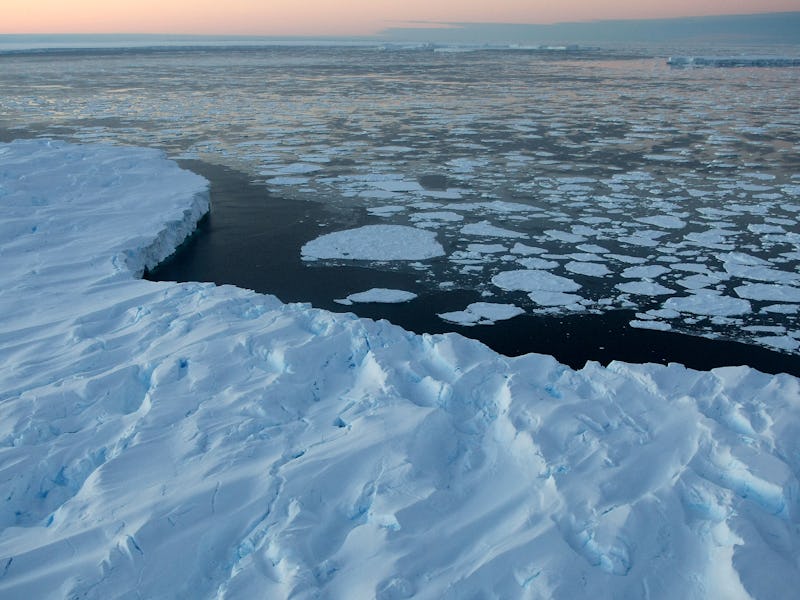Climate Change-Denying MIT Prof. Richard Lindzen Is Suddenly Popular, Still Wrong
Fact-checking the claims of a well-credentialed skeptic.

“Climate change denier” is not a description most atmospheric scientists embrace, but it’s one Richard Lindzen is infamously enthusiastic about. Since the 1990s, Lindzen, a retired MIT professor and previous consultant to NASA’s Goddard Space Flight Center, has been trotted out to different conservative galas and think tanks to recite his impressive résumé and then speak about the evidence that climate change isn’t real.
Predictably, given the presidential election, Lindzen recently put himself back in the spotlight as a guest on RealClear Radio Hour, a program produced by the Competitive Enterprise Institute, an oil industry-affiliated think tank. His comments to host Bill Frezza, gleefully and winsomely transcribed, were posted on the climate skeptic website ClimateDepot by its founder Marc Morano. Lindzen’s comments, met with agreeing hums from Frezza, did want they always do — added new fluff to the regurgitated fodder of climate change deniers. In short, the election-year tradition of listening to Lindzen recite a relatively specific list of claims is still going to be a thing — not unlike the Iowa State Fair or campaigning in New Hampshire diners.
As climate scientist Ray Perrehumbert said in a 2012 lecture to the American Geophysical Union:
“It’s OK to be wrong, and [Richard] is a smart person, but most people don’t really understand that one way of using your intelligence is to spin ever more clever ways of deceiving yourself. … He has made a career of being wrong in interesting ways about climate science.”
Here’s a fact-check of some of his most recent claims:
Claim 1: “You look at the temperature records on the ground, for the satellites, and what you see is something flopping around, a few tenths of a degree. But no obvious trend for at least 18 years.”
Fact: Scientists from the National Oceanic and Atmospheric Administration and the National Centers for Environmental Information published a 2015 paper with evidence that the rate of global warming during the last 15 years has been as fast or faster than seen in the latter half of the 20th century. Furthermore, the average Arctic temperatures have increased at twice the global average rate in the past 100 years and the rate of temperature increase has doubled in the last 50 years.
To fan our drought-induced flames, a 2015 paper in the Bulletin of the American Meteorological Society found that 12 percent of the planet was hotter than it had ever been before. According to NASA and the Japan Meteorological Agency, July of 2015 was the hottest month since we started keeping track of these things.
A victim of drought in Kenya.
Claim 2: “Almost all scientists agree that if you add [carbon dioxide] you will have some warming, although it might be very little. But it is propagandists who translate that into, ‘It’s dangerous and we must reduce [carbon dioxide].’”
Fact: To refresh your memory, carbon dioxide gets trapped in the atmosphere, traps the sun’s heat, and warms the planet. Ancient air bubbles trapped in ice tells us that the levels of carbon dioxide in the atmosphere are higher now than any time in the past 400,000 years.
Researchers measure carbon dioxide in parts per million and, in 2013, we hit the 400 ppm mark, causing NASA’s Michael Gunson to state: “The world is quickening the rate of accumulation of [carbon dioxide], and has shown no signs of slowing this down. It should be a psychological tripwire for everyone.”
Commenting to NPR, Scripps geochemist Ralph Keeling added that 400 ppm seems like a small number, but it’s more than enough to trap a large amount of heat in the atmosphere. Keeling says that “we shouldn’t have let it go over 350” so “we’re already into dangerous territory.”
Scientists believe that Greenland, with its melting ice caps and disappearing glaciers, is an accurate thermometer of global warming.
Claim 3: Lindzen on whether it’s true that 97 percent of scientists agree that catastrophic global warming is inevitable: “Of course not.”
Fact: The 97 percent figure comes from a 2013 study that analyzed 11,944 abstracts in peer-reviewed scientific paper, and found that 97 percent of these abstracts endorsed the consensus that humans are causing global warming — a bit different phrasing than what Frezza used. Institutions like NASA interpret this paper as evidence that 97 percent or more of actively publishing climate scientists agree that climate change trends are related to human activity.
Many scientific organizations have endorsed this claim, including the American Association for the Advancement Science, the American Chemical Society, and the America Geophysical Union — and those are just the start of the A’s.
Oh, and 195 countries, who rarely agree on anything, signed a 31-page agreement this year agreeing to limit carbon emissions. So there’s that.
Claim 4: Asked why so many scientist claim they believe in climate change, Lindzen has this to say: “You could be cynical and say that when the funding goes up by the factor of 10 or 20. That has an influence.”
Fact: Lindzen has been saying since 2009, at least publicly, that the reason his peers believe in climate change is because they want more attention and more funding. Meanwhile, we know from Harpers that, in 1995, he charged “oil and coal interests $2,500 a day for his consulting services,” his trip to testify before Senate in 1991 was paid for by Western Fuels, and his speech “Global Warming: the Origin and Nature of Alleged Scientific Consensus” was underwritten by the Organization of the Petroleum Exporting Countries.
This has been another edition of the Robert Lindzen road show!